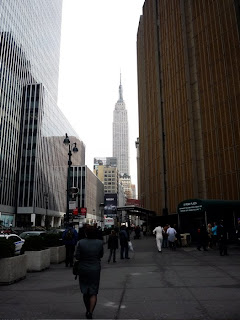J.P. Elephant: Drawing Babar at the Morgan
 I thought that seeing the exhibition Drawing Babar: Early Drafts and Watercolors
I thought that seeing the exhibition Drawing Babar: Early Drafts and Watercolors Furthermore, one of my companions had just reminded me of Adam Gopnik's piece in The New Yorker, an essay in which the writer takes on Ariel Dorfman's accusations of Babar's complicity in advancing French imperialism. Gopnik argues to the contrary, that Jean de Brunhoff’s stories, beginning with The Story of Babar, published in 1931, is a comic send-up of the French colonial mentality rather than an endorsement of it. At any case, I was thinking, "Poor Babar." I felt like a parent wanting to cover a child's ears to protect him or her from things said in the room, although, in this case, the child's ears are really, really big.
Though a widely admired work for children, The Story of Babar
The exhibit focuses on the first book in the series by the father Jean, who published seven tales before dying of tuberculosis in 1937, and the first book of many by his son Laurent. In fact, at the opening of the exhibition on Saturday, Laurent, who heard the first tales as a child and started his own following World War II, was in attendance, signing all matter of Babar books for hundreds of fans. His own work as artist and illustrator is more polished yet perhaps more conventional than the idiosyncratic brilliance of his father's. One of the most wonderful drawings I've seen recently is Jean's sketch of the photographic image of Babar. Our little elephant is so darn cute in his pomposity. While looking at how Babar wants himself represented, and this photograph is an example, I found myself comparing his portrait with the ones of JP Morgan elsewhere on the premises.
Manuscripts and books are the Morgan's strong suit, and the delight in the exhibit comes from encountering the sketches and quick washes that served as visual ideas for the published books. Seeing how the Brunhoffs sketched and composed each page of the Babar series, with cut-out pasted drawings and pencil lines, makes one yearn for the pre-desktop digital days, or at least, the distant happy memories of an elementary school art class. Several children in attendance cared little about this aspect or even about looking at the works on the wall. They were more interested in grabbing one of the many copies of the book on display, sprawling on the floor and demanding their parents to read it out loud to them.
See also:
Adam Gopnik, "Freeing the Elephants: What Babar Brought," September 22, 2008 The New Yorker.
and Edward Rothstein, "All About Mr. Elephant, in His Becoming Green Suit," September 22, 2008. New York Times.
“Drawing Babar: Early Drafts and Watercolors,” through January 9, 2008 at the Morgan Library & Museum, 225 Madison Avenue, at 36th Street; (212) 685-0008. Image above by Walking Off the Big Apple, September 20, 2008.





Comments
Post a Comment